DCA in crypto is a way to invest without timing the market and to simplify the entire process. For investors, the idea of selecting the right time to buy creates a strong dilemma, and DCA is a more structured approach with fixed investment amounts.
In this guide, we explain what DCA in crypto is, how it works, and the advantages of this strategy.
What is DCA in Crypto
DCA, or dollar-cost averaging, is a way to invest in cryptocurrencies over a long period, regardless of market volatility. The strategy means that a person invests a fixed amount of money in a crypto asset at regular intervals – for example, on the 1st of the month. So instead of allocating a larger sum of money all at once, the person spreads the same investment over time.
A simple example is investing $500 in Bitcoin on the 1st of the month, then buying the same face value amount each month for a year.
What does DCA stand for in crypto
DCA stands for “dollar-cost-averaging” and refers to a way to average your cost per unit as you invest at fixed intervals. Over time, averaging the investment can lower or raise your cost per unit and be a better alternative than making a single larger purchase.
How to use DCA in crypto
To use DCA in crypto as a well-thought-out strategy, a person needs to define their goals, their investment period, their allocation, and a recurring plan. Then the process is straightforward, requires commitment, and includes automation to avoid having to manually purchase or forget to make purchases. Here is a straightforward plan to do so:
- Investors need to determine how much they want to allocate each month and their total allocation.
- Then they need to look at how they want to invest. Some people prefer to invest every month, while others prefer a bi-monthly allocation. Other options include weekly or even daily expenses, depending on preference.
- Use crypto investment platforms or crypto exchanges to automate recurring purchases. This removes the need to execute trades manually and maintains the plan stable.
- Regularly review the investment process to avoid overspending and to understand how your portfolio has grown.
How is DCA calculated in crypto
DCAing is calculated by dividing the total investment amount by the total number of Bitcoin or Ethereum you currently hold. To simplify the process, we will use ETH at $3,500 as a point of reference.
For instance, if you invested $10,000 over a period of 12 months and accumulated 3.6 ETH, then the average ETH purchase price would look like this.
DCA = Total investment amount ÷ Total units purchased
$10,000 ÷ 3.6 ETH = $2,777
This means that I might have purchased ETH when it was below $2,777, but also made purchases above that price. With the current Ethereum price at $3,500, the strategy paid off.
Is DCA an effective strategy?
Dollar-cost averaging (DCA) can be a useful strategy for investors who prefer a hands-off approach and don’t want to constantly monitor prices. Data shows that daily DCA in crypto outperforms one-time investments by only 1-3%. However, using a monthly DCA strategy can yield a potential profit margin of 50% compared to one-time investments.
This effectiveness is primarily due to crypto’s volatility, allowing investors to benefit from price drops of 20-30% during specific periods. In the past, DCA was even more profitable, as Bitcoin’s price fluctuations could reach 65% over specificperiods.
Advantages of Dollar-Cost Averaging
- Reduces the impact of market volatility: By spreading investments over time, you avoid the risk of putting all your eggs in the market just before a downturn.
- Eliminates the need to time the market: You don’t need to predict whether prices will rise or fall. You simply invest consistently, regardless of market conditions.
- Encourages disciplined investing: Automation removes emotional decision-making and helps you stay committed to your investment plan.
- Low barrier to entry: You don’t need a large lump sum to start investing. DCA makes crypto accessible with smaller, regular contributions.
Drawbacks of Dollar-Cost averaging
- Potential for lower returns in a bull market: If prices consistently rise, a lump-sum investment at the beginning would have generated better returns than spreading purchases over time.
- Requires patience and discipline: DCA is a long-term strategy. You need to maintain consistency even during market downturns.
- Not suitable for short-term investors: If you’re looking for quick profits, DCA’s gradual approach may not align with your goals.
What is an example of DCA in crypto
A classic example of DCA is Bitcoin dollar-cost averaging from 2018 to 2021, if we consider someone who invested $100 every week in Bitcoin right after the 2018 crash at around $3,500 and continued investing until the 2021 bull run of approximately $65,000.
They would have invested a total of $15,000 over a period of three years. The results show a potential increase of approximately 700% if BTC were to reach $65,000, which is a 7x return with minimal effort.
Build your crypto portfolio with confidence
Dollar-cost averaging offers a disciplined approach to crypto investing that reduces stress and helps manage volatility. By investing fixed amounts at regular intervals, you remove the guesswork from timing the market and build your portfolio gradually.
If you want exposure to the crypto market without the hassle of managing DCA purchases yourself, Yieldfund offers three investment plans with up to 60% annual interest. As a quantitative trading company, we handle the complexity of trading while you enjoy returns and weekly payouts.
FAQ
How often should I DCA in crypto?
Following a DCA strategy in crypto depends on the capital available, but we believe monthly investments perform better than weekly DCAing.
What crypto is good for DCA?
Based on our experience, higher-cap assets like Bitcoin and Ethereum are better suited, as they are more stable than smaller altcoins. While altcoins do have higher volatility, this also entails greater risk.


